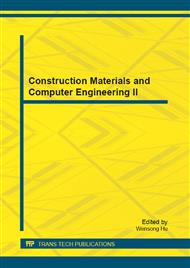p.27
p.31
p.35
p.43
p.51
p.65
p.69
p.77
p.85
Compressive and Tensile Strength of Artificially Cemented Dune Sand
Abstract:
Artificial cementation is a technique commonly used to improve the mechanical properties of soils for use in geotechnical engineering works, because it often provides economic and environmental advantages. In order to study the factors that influence the behavior of cemented dune sand from Natal, series of unconfined compression and splitting tension tests were performed. These tests showed that increasing the cement content and decreasing void ratio are effective ways to improve compressive strength. The same applies to tensile splitting strength. It was also established that both unconfined compressive and splitting tensile strengths can be related to a quotient between volume of void-space and cement content.
Info:
Periodical:
Pages:
51-61
Citation:
Online since:
July 2013
Price:
Сopyright:
© 2013 Trans Tech Publications Ltd. All Rights Reserved
Share:
Citation:


